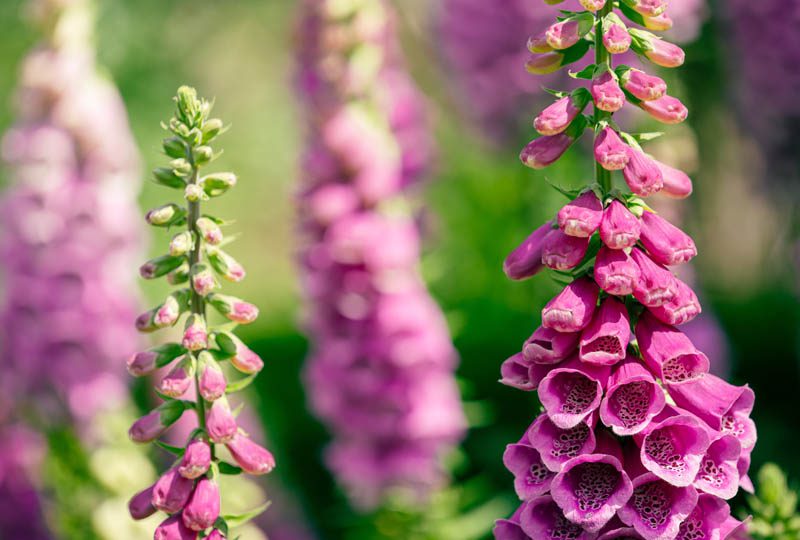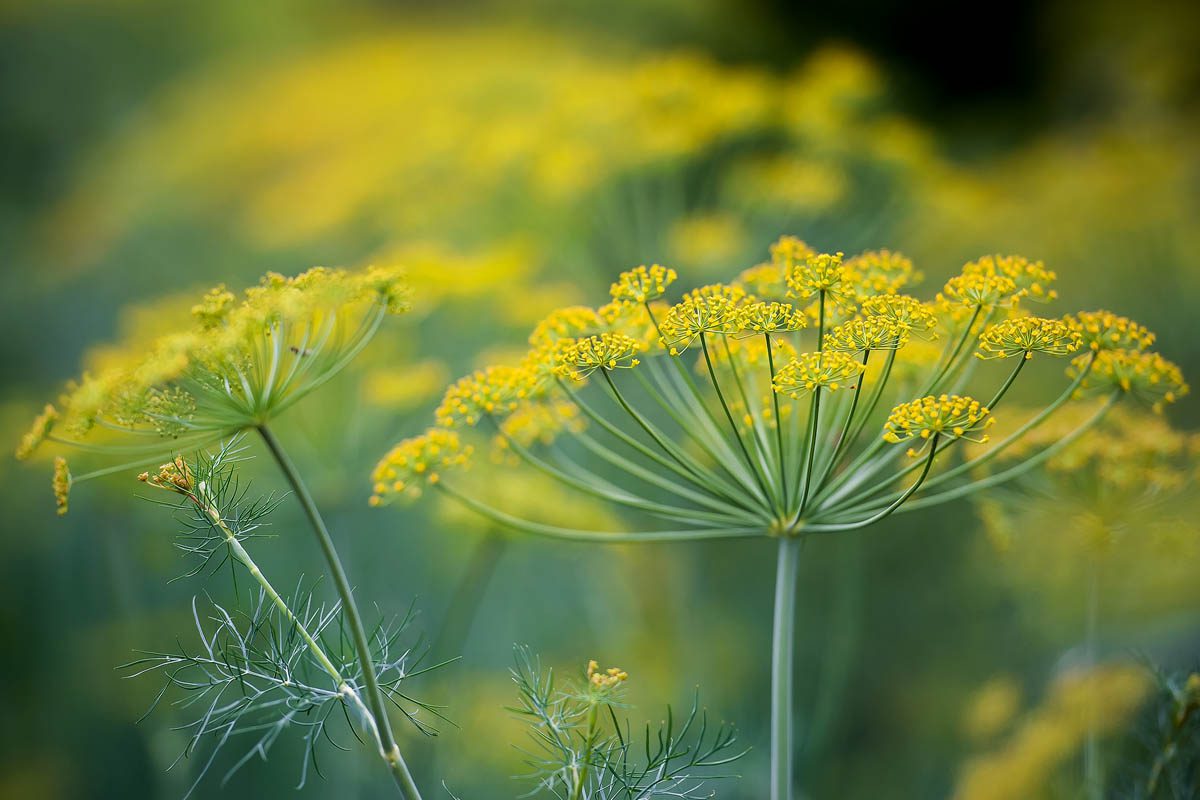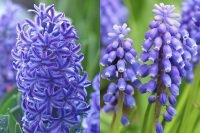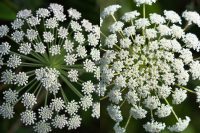A raceme is a type of inflorescence (flower cluster) characterised by an unbranched, elongated main axis (called a rachis or peduncle) where individual flowers bloom on short stalks called pedicels. Racemes are one of the most common flower structures in angiosperms (flowering plants).
Characteristics of a raceme
The defining characteristic of a raceme is its unbranched structure. Racemes feature a main stem, from which multiple flowers bloom on individual stalks. The flowers are usually evenly spaced along the stem to create a symmetrical pattern. Flowers at the base of the stem bloom first, and the blooming progresses upwards to the tip of the stem, where the youngest flowers are located. This sequential blooming is known as ‘acropetal succession‘.

The length of racemes and the number of flowers can vary depending on the plant species. Racemes can stand upright (foxglove) or droop downwards (English bluebell).
Flowers on a raceme bloom from individual buds at the base of each pedicel. Each bud blooms into a flower, starting with the base flowers, and continuing up the stem. In most racemes, the flowers are arranged in a spiral pattern around the stem, however, some may be arranged in opposite pairs.
The term ‘raceme’ comes from the Latin ‘racēmus‘ which means ‘cluster or bunch.‘
Types of racemes
The different types of racemose inflorescences are based on various factors related to their structure, growth pattern, and arrangement of flowers.
- Simple raceme: Each flower is attached to a single, main axis by its own stalk or pedicel.
- Compound raceme: Made up of multiple smaller racemes (known as partial racemes or pedicels), attached to a central axis. Each partial raceme may further bear its own set of flowers.
- Pedicellate raceme: Individual stalks or pedicels attach to the main stalk, but unlike a simple raceme, these pedicels are further attached to secondary axes or branches, resulting in a more complex branching structure.
- Sessile raceme: Flowers are directly attached to the main axis without individual stalks or pedicels.
- Corymbose raceme: A raceme that is characterised by a central axis producing multiple pedicels, each bearing a flower. These flowers are arranged in flat-topped or slightly convex clusters. All flowers reach approximately the same height which creates a visually appealing and symmetrical display. Examples include hawthorn and mountain ash.
- Indeterminate raceme: New flowers develop at the base of the raceme as it continues to grow, resulting in a continuous elongation of the inflorescence.
- Determinate raceme: The number of flowers is set in advance, and the growth halts once all the flowers have blossomed. Unlike indeterminate racemes, which continue to produce new flowers at the apex as the inflorescence lengthens.
Difference between a raceme and an inflorescence
Inflorescence refers to how flowers are arranged on a plant and encompasses various patterns and structures. Racemes are a type of inflorescence, but there are numerous other types of inflorescence such as spike, umbel, catkin, corymb, cyme and spadix.
Why is it important to understand racemes?
Racemes are an important aspect of botany as this inflorescence provides crucial information on the plant’s identity, growth habits and reproductive strategies.
Many plant species have characteristic inflorescences and recognising a raceme helps to identify a plant’s genus or species. The structure of a raceme plays an important role in a plant’s reproductive success. Racemes flower from the bottom to the top. This sequential blooming pattern maximises the plant’s chances of being pollinated over an extended period.
Basics of plant morphology
Plant morphology is the study of the physical form and external structures of plants. This involves understanding the roots, stems, leaves and flowers. Each component has a unique and vital role in the plant’s growth, reproduction and survival. For example, the roots anchor the plant and absorb water and nutrients, the leaves are the main sites for photosynthesis.
One of the key elements of plant morphology is the inflorescence, which refers to the arrangement of flowers on the plant. The structure and pattern vary widely among plant species. Some plants, such as a rose or a dahlia, produce a single flower at the end of a stem while other plants produce multiple flowers in clusters, spikes or racemes. The structure of the inflorescence plays a role in how the flowers are pollinated.
Which plants have racemes?

| Plant Name | Description |
|---|---|
Foxglove (Digitalis spp.) |
Tall biennial or short-lived perennial plant known for its long, bell-shaped flowers arranged in a raceme. The flowers are often purple, but can also be white, yellow, or pink. |
Snapdragon (Antirrhinum majus) |
A tender perennial known for its colourful, two-lipped flowers that are arranged along a tall, slender raceme. The flowers can be a variety of colours, including red, pink, orange, yellow, and white. |
Wisteria (Wisteria spp.) |
A genus of flowering plants known for their spring-blooming fragrant, pendulous racemes in purple or white. |
Black locust (Robinia pseudoacacia) |
A fast-growing deciduous tree known for its fragrant, white, pea-like flowers that hang in drooping racemes, its deeply furrowed bark, and compound leaves, often planted for its ornamental and timber qualities despite its invasiveness in certain regions. |
Lupine (Lupinus spp.) |
Known for their tall spikes of colourful flowers arranged in a raceme. The flowers can be blue, purple, pink, or white. |
Delphinium (Deliphinium spp.) |
A short-lived perennial and cottage garden favourite grown for its tall, showy, pink, blue or white flowers which bloom from spring t summer. |
Lily of the Valley (Convallaria majalis) |
A herbaceous bulb with sweetly scented, white, bell-shaped flowers that hang from a curved, unbranched raceme. |
Dame’s rocket (Hesperis matronalis) |
Clusters of fragrant, purple, pink, or white flowers arranged in a raceme. Blooms in the late spring or early summer. |
Sweet alyssum (Lobularia maritima) |
Small, fragrant flowers that are usually white but can also be pink or purple. The flowers are arranged in a raceme and bloom from spring to autumn. |
Coral Bells (Heuchera spp.) |
Tall, slender racemes of small, bell-shaped flowers that can be white, pink, or red. The flowers bloom in the late spring or early summer. |
Lilac (Syringa vulgaris) |
A deciduous shrub grown for its clusters of highly fragrant, purple or white arranged in large conical racemes. Lilacs flower in late spring and provide a rich source of nectar for pollinators. |
Bleeding heart (Lamprocapnos spectabilis) |
A perennial plant with heart-shaped pink and white flowers that hang in a line from arching stems, blooming in spring and early summer. |
Sweet pea (Lathyrus odoratus) |
An annual climbing plant with highly fragrant flowers that grow in a wide range of colours, and are arranged in a raceme. |
Horse-chestnut (Aesculus hippocastanum) |
A large deciduous tree with palmate leaves, showy upright racemes of white or pink flowers with yellow to red spots, and spiny fruits containing glossy brown seeds, often referred to as ‘conkers‘. |
Hyacinth (Hyacinth spp.) |
A bulbous perennial plant, with spike-like clusters of highly fragrant, bell-shaped flowers that grow in pink, purple, red, white, and yellow. |
Variations within racemes across different species
All racemes share the same basic structure of an unbranched stem with flowers on individual stalks, there is still a great deal of variation within this form.
- The racemes of snapdragon are dense, with closely packed flowers, while those of delphinium are looser and much more open.
- The orientation of the raceme can also have variations. Wisteria has pendulous racemes, which droop or hang downwards, while those of a lupine stand erect.
- Size and colour of flowers can also differ between species. Delphiniums have large, showy flowers that grow in several colours, while the flowers on a blackberry raceme are small and white or pink.
In summary, while the basic structure of a raceme is consistent, the specific characteristics can vary greatly between different species and cultivars, leading to a rich diversity of forms.
Other types of inflorescences

- Panicle: A panicle is a branched inflorescence with flowers arranged on secondary or tertiary stems called pedicels. Unlike unbranched racemes, panicles have a more complex structure. Examples of plants with panicle inflorescences include oats and rice.
- Spikes: The flowers are directly attached to the pain stem without pedicels, to form a long, unbranched column. Examples include gladiolus and wheat.
- Umbels: The umbel is made up of a number of short flower stalks (pedicels) that spread from a common point, similar to umbrella ribs. Flowers bloom at the same level, to create a flat, or convex shape. Examples include Queen Anne’s lace and fennel.
- Corymb: A type of inflorescence in which the flower stalks grow upward from various points on the main stem to approximately the same height, to create a flat-topped or slightly convex cluster of flowers.
- Cyme: A type of inflorescence where the central or topmost flower blooms first, promoting a broad, flat-topped flower cluster, which can be seen in plants like the bougainvillea, baby’s breath, and the common elder.
- Spadix: A thick, fleshy axis covered in tightly-packed, tiny flowers, that is surrounded by a distinctive bract, as seen in plants like calla lilies, peace lilies, and anthuriums.
The role of racemes in plant reproduction

Racemes play a critical role in plant reproduction by holding and displaying the flowers, that contain the plant’s reproductive organs. The flower arrangement in a raceme makes the plant visible to pollinators. The elongated, and typically vertical presentation of the flowers stands out. In addition, the sequential blooming, which starts at the bottom and progresses upwards, provides a consistent source of nectar and pollen over an extended period, which increases the chance of pollination. Some plants with racemes such as lilac, English bluebells and hyacinth also produce highly fragrant flowers which attract pollinators.
Conclusion
Understanding the function and structure of plant racemes provides valuable insights into the plant’s reproductive and survival strategies. The design maximises the plant’s reproductive potential and extends its blooming period. This can impact the ecosystem, by influencing biodiversity and distribution of plant species. Recognising racemes also helps botanists with plant identification. |
Julia is a writer and landscape consultant from Wollongong with a love of horticulture. She had been an avid gardener for over 30 years, collects rare variegated plants and is a home orchardist. Julia is passionate about learning and sharing her knowledge of plant propagation and plant toxicology. Whether it’s giving advice on landscape projects or sharing tips on growing, Julia enjoys helping people make their gardens flourish.




